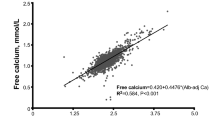Abstract
Hypercalcemia is ideally detected by the measurement of serum ionised calcium. Because this is not widely available, in common clinical practice “albumin-corrected” calcium values are often utilized. Our study investigated whether the method used to measure serum albumin concentration may significantly interfere in the derived serum calcium values and, consequently, in the identification of hypercalcemic patients. In 170 consecutive patients admitted to our Department of Internal Medicine we measured serum total calcium, total protein, and albumin by colorimetric method; albumin concentration was also derived by electrophoresis assessment. After correcting serum calcium for colorimetrically (CA) and electrophoretically (EA) measured albumin values, the detected frequencies of hypercalcemia were compared, utilizing different cut-off limits (i.e. 11.0, 10.4 and 10.2 mg/dl). In our patients, the CA values were significantly lower than EA levels. As a consequence, EA-corrected calcium, as well as total calcium concentration were significantly lower than CA-corrected values. This may also account for the very different prevalence of hypercalcemic patients identified by serum total, EA-corrected and CA-corrected calcium values. Our data therefore indicate the importance of the method of albumin measurement in the determination of “corrected“ calcium concentration.
Similar content being viewed by others
References
Palmer M, Jakobsson S, Akerstrom G, Ljunghall S. Prevalence of hypercalcemia in a health survey: a 14-year follow-up study of serum calcium values. Eur J Clin Invest 1988, 18: 39–46.
Frolich A, McNair P, Transbol I. Awareness of hypercalcemia in a hospital population? Scand J Clin Lab Invest 1991, 51: 37–41.
Frolich A. Prevalence of hypercalcemia in normal and in hospital populations. Dan Med Bull 1998, 45: 436–9.
Lundgren E, Rastad J, Thurfjell E, Akerstrom G, Ljunghall S. Population-based screening for primary hyperparathyroidism with serum calcium and parathyroid hormone values in meno-pausal women. Surgery 1997, 121: 287–94.
Jorde R, Bonaa KH, Sundsfjord J. Primary hyperparathyroidism detected in a health screening. The Tromso study. J Clin Epidemiol 2000, 53: 1164–9.
Lundgren E, Hagstrom EG, Lundin J, et al. Primary hyperparath-yroidism revisited in menopausal women with serum calcium in the upper normal range at population-based screening 8 years ago. World J Surg 2002, 26: 931–6.
Carroll MF, Schade DS. A practical approach to hypercalcemia. Am Fam Physician 2003, 67: 1959–66.
LeBoff MS, Mikulec KH. Hypercalcemia: clinical manifestations, pathogenesis, diagnosis, and management. In: Murray JF ed. Primer on the Metabolic Bone Diseases and Disorders of Mineral Metabolism. 5th ed. 2003, 225–30.
Eustace JA, Astor B, Muntner PM, Ikizler TA, Coresh J. Prevalence of acidosis and inflammation and their association with low serum albumin in chronic kidney disease. Kidney Int 2004, 65: 1031–40.
Besarab A, Caro JF. Increased absolute calcium binding to albumin in hypoalbuminemia. J Clin Pathol 1981, 34: 1368–74.
Dickerson RN, Alexander KH, Minard G, Croce MA, Brown RO. Accuracy of methods to estimate ionised and “corrected” serum calcium concentrations in critically ill multiple trauma patients receiving specialized nutrition support. JPEN J Parent-er Enteral Nutr 2004, 28: 133–41.
Bilezikian JP, Potts JT Jr, El Hajj Fuleihan G, et al. Summary statement from a workshop on asymptomatic primary hyperparathyroidism: a perspective for the 21st century. J Bone Miner Res 2002, 17 (Suppl2): N2–11.
Pedersn KO. An analysis of measured and calculated calcium quantities in serum. Scand J Clin Lab Invest 1978, 38: 659–67.
Hill PG. The measurement of albumin in serum and plasma. Ann Clin Biochem 1985, 22: 565–78.
Shek CC, Natkinam A, Tsang V, Cockram CS, Swaminathan R. Incidence, causes and mechanism of hypercalcemia in a hospital population in Hong Kong. Q J Med 1990, 77: 1277–85.
Author information
Authors and Affiliations
Corresponding author
Rights and permissions
About this article
Cite this article
Carnevale, V., Pipino, M., Antonacci, M. et al. Prevalence of hypercalcemia in hospitalised patients: Effects of “correction” for serum albumin values. J Endocrinol Invest 28, RC15–RC17 (2005). https://doi.org/10.1007/BF03347215
Accepted:
Published:
Issue Date:
DOI: https://doi.org/10.1007/BF03347215




